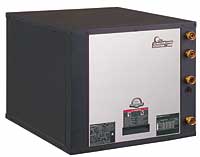This was the problem faced by a young family in Wimberley, Texas; they decided that after eight months in a new home, something had to be done about their comfort levels and utility bills. After doing some research, the homeowners initially thought a high-efficiency, air-to-air heat pump would best replace their electric furnace and air conditioner.
Then they talked to Tom Romberg, owner and operator of Action Mechanical Services Inc., who told them about the benefits of geothermal systems. The homeowners were intrigued. They decided to have Romberg rip out their relatively new equipment and replace it with ClimateMaster's brand-new Tranquility 27 two-stage geothermal heat pump.

Variable-Speed Product
ClimateMaster introduced the Tranquility 27 in May, which is designed for geothermal and high-end water-loop applications. (Incidentally, the Tranquility 27 was also a hit with contractor-judges who awarded it the bronze medal inThe News'2004 Dealer Design Awards.)The Tranquility 27 uses R-410A, optimized heat exchangers, Copeland Ultratech scroll compressors, and GE ECM motors to deliver two steps of capacity. "The system is a packaged geothermal heat pump, and therefore does not require any outdoor equipment or refrigerant piping. Once the ground loop is installed, water piping is connected to the unit and it's ready to go," said Daniel Ellis, president of ClimateMaster, Oklahoma City.
He said other benefits of the series include a rating of 27 EER, a GE variable-speed fan, a MERV-11 2-inch pleated filter with filter rack, microprocessor controls with diagnostics, a stainless steel drain pan, foil-backed air handler insulation, coated air coils, and stainless steel access panels.
"The benefits include lower operating costs, longer life expectancy, quieter operation, environmentally friendly space conditioning, easier maintenance, better indoor air quality, and better indoor comfort," Ellis said.
These benefits were very attractive to the Wimberley homeowners, who asked Romberg for more information.
Romberg performed a Manual J8 load analysis to calculate the size system needed for the 2,101-square-foot home. He used design conditions of 98 degrees F outdoor temperature and 75 degrees inside temperature to determine that the home needed a 3.5-ton system.
"That size was not available, so I chose a 4-ton system, whose capacity at low speed is very good," said Romberg.
"It seemed appropriate that we would get the 4-ton unit and therefore, most of their running hours would be in the low speed," he explained.
In a two-speed machine, the two capacities are 100 percent and 50 percent or 100 percent and 47 percent. "In the Tranquility, it's 100 percent or 6 percent, so it has more capacity in the low speed than comparable two-speed machinery and therefore is going to run longer hours in that low-speed, very-high-efficiency performance."
Romberg also used ClimateMaster's GeoDesigner software to predict the cost of heating, cooling, and hot water assist as compared to more traditional sources (i.e., natural gas, propane, or air-to-air heat pumps). The software predicted that the geothermal system would have an annual heating cost of $168, a cooling cost of $365, and a water heating cost of $227, for a total of $760. For a 12-SEER, air-to-air heat pump, the software figured a heating cost of $324, cooling cost of $551, and a straight water heating cost of $384, for a total of $1,259. The homeowners gave Romberg the go ahead.

Other Modifications
The contractor installed the geothermal system over two days in June. One day was spent drilling and installing the pipes vertically in the ground; the second day was spent installing the equipment itself."We were able to run the water pipes through the wall in their master dressing closet and mount the circulating pump on that inside wall, then go on up into the attic," said Romberg. "Then we took the machine up through the pull-down stairway opening and mounted it there, hooking up the ductwork from the existing machine to the geothermal system. Then we fired it up. It was beautiful."
In addition, the contractor installed a Carrier Thermidistat, which turns on the system for dehumidification purposes. "In the spring and fall, especially, we don't need as much cooling in our area but we do need to take the humidity down. When we're dry inside, we're more comfortable at a higher temperature," noted Romberg.
An electronic air cleaner was also installed. Romberg said he is not a fan of traditional electrostatic air cleaners, so he installed an electronic, two-stage precipitator instead, which he believes is more efficient. He also sealed the homeowner's ductwork and will soon be performing duct system testing in order to reduce leakage further. The homeowners also wanted the 10-year labor warranty with their system.

"In most cases, residential geothermal systems are approximately twice the cost of ‘traditional' heating and cooling systems, due to the installation of the ground loop," said Ellis. "Open-loop (well water) systems may cost the same or even less than the highest efficiency furnace and air conditioning system. However, operating costs are typically one-half that of traditional systems."
Although the first cost of geothermal is usually higher, when it is put into the mortgage, the payment goes up by less than the amount homeowners can save each month on operating costs. Thus, the end user is generally cash flow positive from day one, explained Ellis.

"The homeowner can make an investment decision, whereas builders are always scared that the price is going to be higher and that will jeopardize their ability to get jobs. Builders also don't like anything new or different, but homeowners are asking for geothermal," stated Romberg. "I just have to have the opportunity to speak with them."
For more information, visit www.climatemaster.com.
Publication date: 08/23/2004


Report Abusive Comment